- info@wildlife-removal.com
Call us for help in your town
Wildlife Removal Education
How to get a raccoon out of the house
Need raccoon removal in your hometown? We service over 500 USA locations! Click here to hire us in your town and check prices - updated for year 2020.
If you have a raccoon in the attic or chimney of the house, you might want to read my raccoons in the attic or raccoons in the chimney guide. But if you have a raccoon actually inside the living space
of the house - like in the kitchen or living room or bathroom or something, well then that's an emergency situation. What are you doing on your computer?
Step 1) Don't panic! Be safe. Don't confront the raccoon or corner it, or it'll defend itself. It won't attack for no reason. Lock your kids and pets in another room!
Step 2) Open all the windows and doors you can safely open and then get out of there. Let it go out on its own.
Step 3) If you can't open anything, try to usher it out with a broom. But don't get too close! If you've got an animal snare pole, that works very well.
Step 4) Maybe you should just call a wildlife removal company.
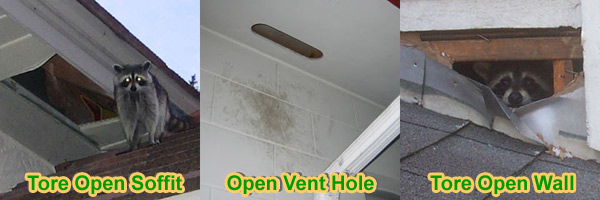
Various ways raccoons get inside a house.
There are many ways a raccoon can get inside a house. They might rip open a soffit, or go through an open vent, or even tear a hole in the wall. They don't usually intend to
get into the living space. That often happens by accident. Usually, they want to live in the attic or walls - someplace away from you,
where they can live and sleep and nest and raise their young in peace. Unfortunately, while doing so they usually create a lot of noise and a lot of damage. Read the guide Noises Raccoons Make When They Live In Your House.
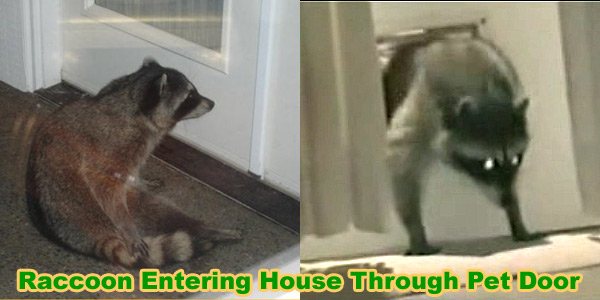
Raccoon entering house through pet door.
One of the most common ways raccoons get into the actual house is via the dog door or cat door. Especially if there's a bowl of food inside on the other end. Raccoons
have a great sense of smell, of course, and they're generally fearless city animals, so if they smell food on the other end of a pet door, heck - just the smell of the
pet alone might make them curious enough - they'll often push their way through the pet door and inside the house. I've seen this many times. Raccoons are curious, smart,
and bold. So if you have this problem, you're going to either need to trap and relocate the offending raccoon who has learned to use the doggie door, or you're going to
have to seal off the door for a few weeks until the raccoon learns that it won't work. Even then, it'll come back, or try to break its way in. Trapping and removal is
often the only answer when a raccoon is habituated a bad way. The Best Ways to Keep Raccoons out of Your House
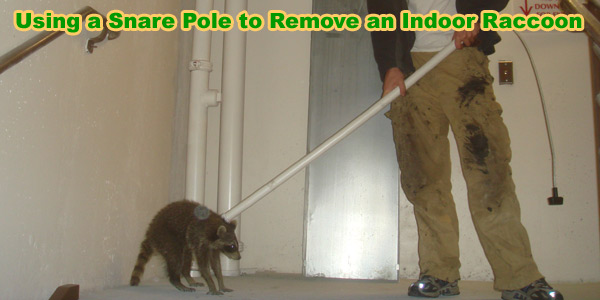
Using a snare pole to remove a raccoon inside a building.
As a professional wildlife removal expert, the most common way I remove raccoons inside buildings and homes is via a snare pole. I quickly lunge and wrap it around the raccoon's chest, tighten, and swiftly swing the animal
into a trap - not always easy, since the animal tends to be very quick and strong. But with practice, I've gotten very good at it, and have no problems now.
How to get raccoons out of the house - the best way, if they're habitually living somewhere in the architecture, is via trapping and removal. If inside the home, then a snare pole is good, or simply opening a door and letting them
out. If it's a repeat offender, and not just a one-time accident, then you've got a problem on your hands, and you'll need to trap and remove the problem raccoon.
Other raccoon articles I've written:
raccoon trapping tips -
how to get rid of raccoons -
raccoons in the pool -
how to trap raccoons -
raccoon bait -
raccoon poop -
raccoon removal -
raccoon in chimney -
raccoon pest control -
raccoon damage -
raccoon repellent
Raccoons are a species that are naturally good climbers, but with the diminishing habitat and increasing numbers of urban and suburban areas in the country, they have had to adapt to living in urban areas too. There are many features of an house that will prove attractive to the raccoon, and the fact that it is often dark and warm makes it an attractive place to build a nest. While doing this they can cause a fair amount of damage, shredding insulation material for the nest, and contaminating it with feces and urine, while also making holes to get in and out of the house.
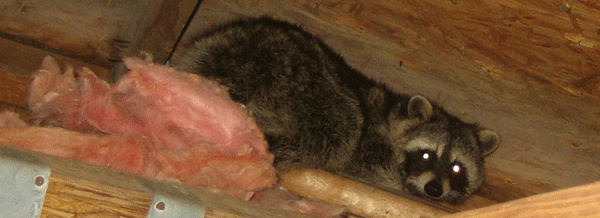
Signs You May Have A Raccoon In The house
Although raccoons are not small animals, they are actually quite skilled at squeezing through fairly small holes, so you won't necessarily see large holes around the roof line when you have a raccoon in the house. However, they can be quite noisy when they are active around dawn and dusk, so sounds of scratching or gnawing from the roof can be a sign of a raccoon being present, while seeing a nest in the house can also be a sign that you may have a problem.
Trapping And Removing A Raccoon
Because of their size, cage traps are usually the best ways to deal with a raccoon if you are looking to carry out the work yourself, and these should be placed in areas where the raccoons are active, with a nice smelly food such as canned fish or cat food being a good bait. Once you've trapped the raccoon, examine it to see if it has any visible nipples, as you may also need to find and remove a nest of baby raccoons too.
Relocating The Animal
You should try to relocate raccoons at least ten miles away from your property, as this will be too great a distance for the raccoons to return, and should also give you time to carry out repairs. Try to avoid releasing them in urban areas where they will go on to be a nuisance to other residents, and look for areas that are well away from domestic or commercial properties.
Repairs And Decontamination
Once you have removed all of the raccoons, carry out a thorough inspection of the house, both internally and externally to find all of the holes the raccoons were using to get in and out, and seal them. You will also need to remove any feces or droppings in the house, and should also consider replacing any soiled insulation. Once this has all been removed, using a fumigated antibacterial agent to completely decontaminate the house from any diseases or spores left behind by the raccoons.
We now service over 500 locations! Click here to hire us for raccoon removal in your town.
We know that you want to freak out when you find yourself with a wild animal interloper, but panicking and stressing out is probably not going to be very productive for you right now. When you stress out, the animal will be able to sense this and will also become stressed. When these wild critters get stressed; however, they don't just sit in a corner with a moody-looking face on. They lash out. And sometimes, they lash out with some force too.
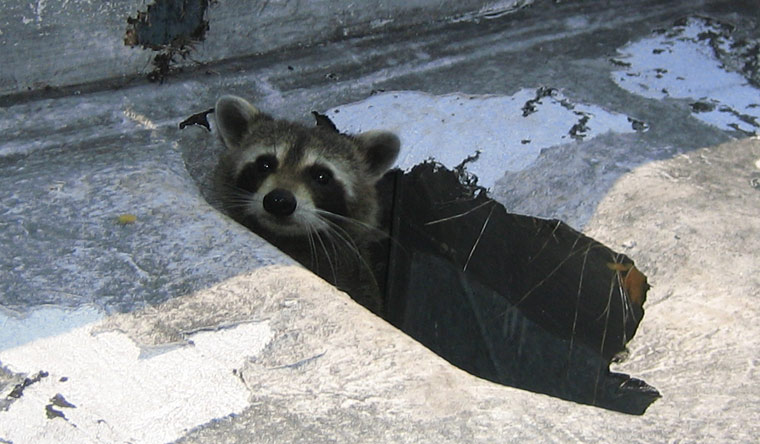
If you have a raccoon in the house, such as in the bedroom, kitchen, living room, etc., try to confine the animal to just one spot. Sadly, once the animal is already inside your home, there is not too much that you have control over, so you must be prepared for things to get broken in that room as the animal panics and likely rushes about. If you can leave a window open so the animal can clamber out, try to do that. If you have a door that you can open that leads outside, even better. Stand back and wait to see what happens — you may just find that the raccoon leaves of its own accord.
If you can safely confine the raccoon to a box, pillow case, or similar, you can attempt this, but make sure that you have protection. One scratch or bite could be fatal in terms of the rabies virus, and there are other disease threats that you will also need to take into consideration.
If the animal can't be confined or doesn't seem to want to leave, you can try to shoo it out, using a broom or similar, but again, you must be prepared to get out the way quickly if the animal turns to lunge at you.
If you can get to the phone, give local wildlife rehabilitators a call. Most of them will offer a same day appointment for emergency situations just like the one we have described, and they can also give you advice — potential ways the animal could have gotten in, for example. You will need to know this information so that you can prevent future attacks from wild animals — you will need to seal up the holes or repair torn vents or screens that allowed the animal to get in, in the first place. Read more about how to keep raccoons away.
Be calm, have a plan, and protect yourself as much as you can. If all removal efforts fail, lock the animal in a room, grab the phone, and let a wildlife removal expert or rehabilitator come in and take the imposter away.
Go back to the Raccoon Removal page, or learn tips to do it yourself with my How to Get Rid of Raccoons guide.
Real Raccoon Situation: David, I have been searching all day in hopes to find somebody who can help me remove raccoons from our dorm buildings. We are located in Fairfield IA...it gets really hot; for instance: today
it’s gotten up to about 80 degrees... will raccoons stay in the attic in hot weather like this? Will they try to come down inside the dorm rooms? (I’m positive there’s been something up there & I just wanted to look, but really don’t wanna encounter a critter…) Thanks for your
time & be well! Please respond if you think you can help us, Thank you so much and have a great day, Kim
My response: Yes, raccoons will tolerate extremely high temperatures in attics, well above 80 degrees, even well above 120 degrees. I don't know how they do it. Anyway, I can't help you in Fairfield, because
I live in Orlando, but someone on my wildlife directory can help.
Real Raccoon Situation: Hello, I live in a rowhouse in west Philadelphia, Pennsylvania. Myself, along with several of my neighbors are having a problem with what we believe is a raccoon or several raccoons that are running through the walls and ceilings of our homes. This is affecting about 8 homes and many of us, including myself, are really terrified. Over the last several months we have all heard the ,running, scratching, dragging noises always in the middle of the night between 3AM and 6AM on different varying nights. The animal is inside of the walls and ceilings. We see raccoons and possums outside and do not have fire walls that separate our houses. This has brought myself and some of our other neighbors to tears in fear thinking that the animals may get inside our homes. Because we live in row houses and some of our neighbors have noticeable holes in their properties we really don't know what to do. We know that some of our other neighbors will not get their holes fixed and we don't know what to do to fix the problem. Please let me know what you suggest. Thanks! Paula
My response: That's a tough case, with rowhomes and the animals able to move freely between the units. The whole structure needs to be addressed. You've got to find out how they are getting in, remove them via trapping or exclusion, and seal the openings up afterward. Make sure the young are big enough to go outside, and into the traps. Have you considered hiring a professional wildlife company?
Article topics include: How to get a raccoon out of a home - raccoons in the house - how to get them out of the home. You can also read about Knocking Sound In Attic.


















